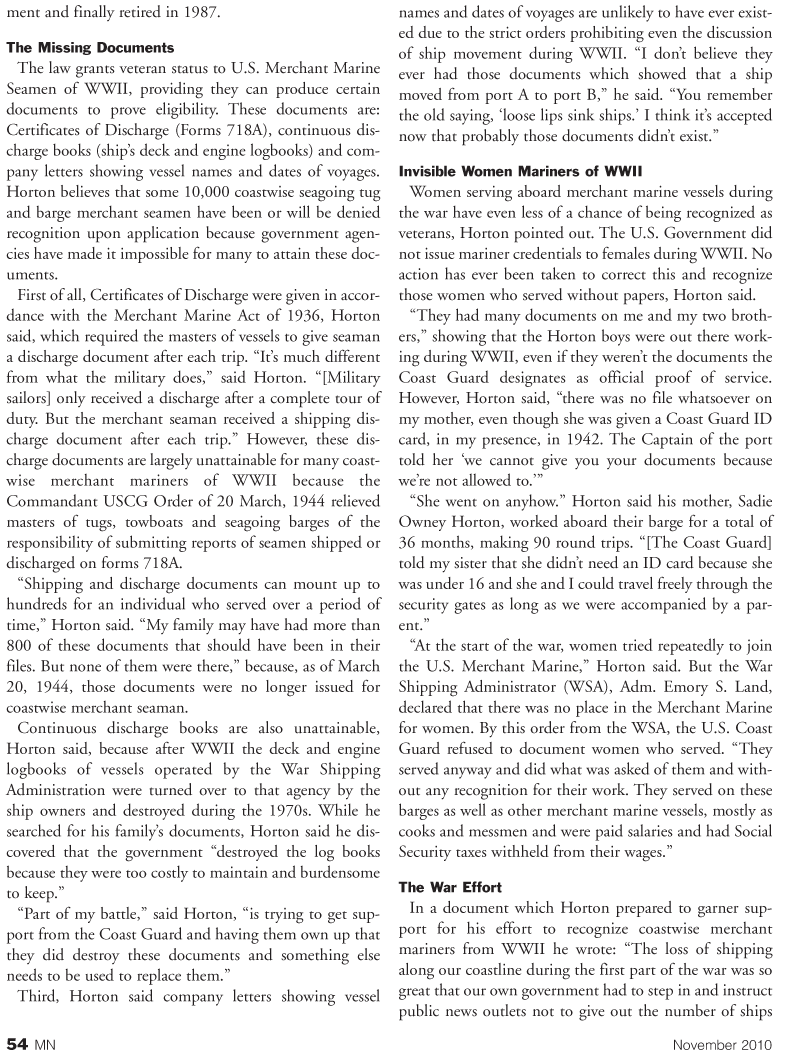
Page 54: of Marine News Magazine (November 2010)
Workboat Annual
Read this page in Pdf, Flash or Html5 edition of November 2010 Marine News Magazine
54 MN November 2010 ment and finally retired in 1987.
The Missing Documents
The law grants veteran status to U.S. Merchant Marine
Seamen of WWII, providing they can produce certain documents to prove eligibility. These documents are:
Certificates of Discharge (Forms 718A), continuous dis- charge books (ship’s deck and engine logbooks) and com- pany letters showing vessel names and dates of voyages.
Horton believes that some 10,000 coastwise seagoing tug and barge merchant seamen have been or will be denied recognition upon application because government agen- cies have made it impossible for many to attain these doc- uments.
First of all, Certificates of Discharge were given in accor- dance with the Merchant Marine Act of 1936, Horton said, which required the masters of vessels to give seaman a discharge document after each trip. “It’s much different from what the military does,” said Horton. “[Military sailors] only received a discharge after a complete tour of duty. But the merchant seaman received a shipping dis- charge document after each trip.” However, these dis- charge documents are largely unattainable for many coast- wise merchant mariners of WWII because the
Commandant USCG Order of 20 March, 1944 relieved masters of tugs, towboats and seagoing barges of the responsibility of submitting reports of seamen shipped or discharged on forms 718A. “Shipping and discharge documents can mount up to hundreds for an individual who served over a period of time,” Horton said. “My family may have had more than 800 of these documents that should have been in their files. But none of them were there,” because, as of March 20, 1944, those documents were no longer issued for coastwise merchant seaman.
Continuous discharge books are also unattainable,
Horton said, because after WWII the deck and engine logbooks of vessels operated by the War Shipping
Administration were turned over to that agency by the ship owners and destroyed during the 1970s. While he searched for his family’s documents, Horton said he dis- covered that the government “destroyed the log books because they were too costly to maintain and burdensome to keep.” “Part of my battle,” said Horton, “is trying to get sup- port from the Coast Guard and having them own up that they did destroy these documents and something else needs to be used to replace them.”
Third, Horton said company letters showing vessel names and dates of voyages are unlikely to have ever exist- ed due to the strict orders prohibiting even the discussion of ship movement during WWII. “I don’t believe they ever had those documents which showed that a ship moved from port A to port B,” he said. “You remember the old saying, ‘loose lips sink ships.’ I think it’s accepted now that probably those documents didn’t exist.”
Invisible Women Mariners of WWII
Women serving aboard merchant marine vessels during the war have even less of a chance of being recognized as veterans, Horton pointed out. The U.S. Government did not issue mariner credentials to females during WWII. No action has ever been taken to correct this and recognize those women who served without papers, Horton said. “They had many documents on me and my two broth- ers,” showing that the Horton boys were out there work- ing during WWII, even if they weren’t the documents the
Coast Guard designates as official proof of service.
However, Horton said, “there was no file whatsoever on my mother, even though she was given a Coast Guard ID card, in my presence, in 1942. The Captain of the port told her ‘we cannot give you your documents because we’re not allowed to.’” “She went on anyhow.” Horton said his mother, Sadie
Owney Horton, worked aboard their barge for a total of 36 months, making 90 round trips. “[The Coast Guard] told my sister that she didn’t need an ID card because she was under 16 and she and I could travel freely through the security gates as long as we were accompanied by a par- ent.” “At the start of the war, women tried repeatedly to join the U.S. Merchant Marine,” Horton said. But the War
Shipping Administrator (WSA), Adm. Emory S. Land, declared that there was no place in the Merchant Marine for women. By this order from the WSA, the U.S. Coast
Guard refused to document women who served. “They served anyway and did what was asked of them and with- out any recognition for their work. They served on these barges as well as other merchant marine vessels, mostly as cooks and messmen and were paid salaries and had Social
Security taxes withheld from their wages.”
The War Effort
In a document which Horton prepared to garner sup- port for his effort to recognize coastwise merchant mariners from WWII he wrote: “The loss of shipping along our coastline during the first part of the war was so great that our own government had to step in and instruct public news outlets not to give out the number of ships

 53
53

 55
55
